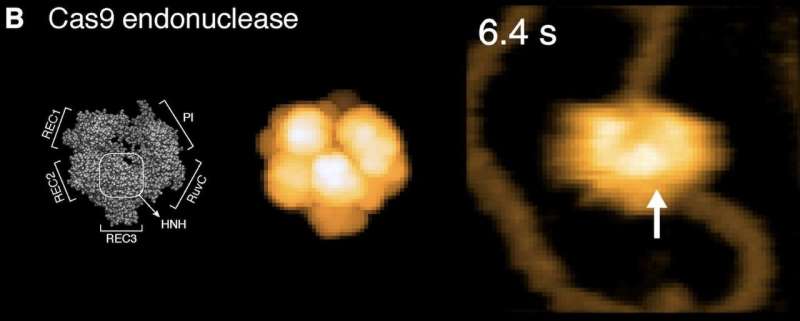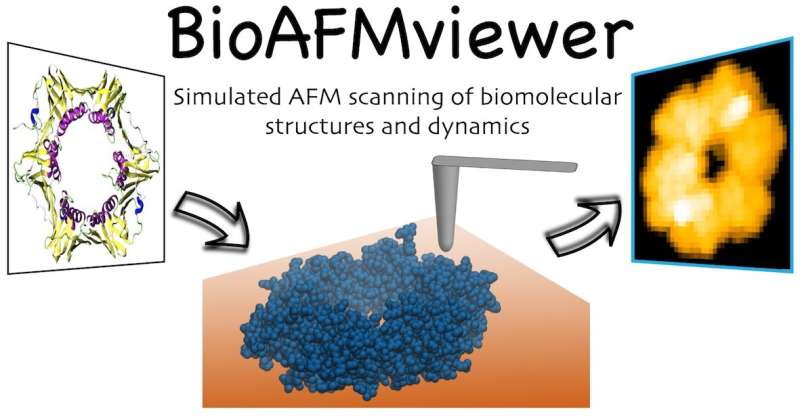Comparison of simulated AFM graphics to high-speed AFM experiments for the Cas9 endonuclease protein. The simulated AFM graphics (middle) of the molecular structure (left) very well agrees with the experimental image obtained from high-speed AFM (right). The experimental image is adopted from the publication: M. Shibata et al. Nat. Commun. 8: 1430 (2017). Credit: Kanazawa University
Nowadays nanotechnology allows one to observe single proteins at work. Under atomic force microscopy (AFM), e.g., their surface can be rapidly scanned, and functional motions monitored, which is of great importance for applications in all fields of the life sciences. The analysis and interpretation of experimental results remains however challenging because the resolution of obtained images or molecular movies is far from perfect. On the other side, high-resolution static structures of most proteins are known, and their conformational dynamics can be computed in molecular simulations. This enormous amount of available data offers a great opportunity to better understand the outcome of resolution-limited scanning experiments.
The developed software provides the computational package towards this goal. The BioAFMviewer computationally emulates AFM scanning of any biomolecular structure to generate graphical images that resemble the outcome of AFM experiments . This makes the comparison of all available structural data and computational molecular movies to AFM results possible. The BioAFMviewer has a versatile interactive interface with rich functionality. An integrated 3-D viewer visualizes the molecular structure while synchronized computational scanning with adjustable tip-shape geometry and spatial resolution generates the corresponding simulated AFM graphics. Obtained results can be conveniently exported as images or movies.
To demonstrate the great potential of simulated AFM scanning in supporting the analysis and interpretation of experimental data, the authors provide several applications to high-speed AFM observations of proteins. As an example, for the gene scissor related CRISPR-associated protein 9 endonuclease (Cas9), simulated scanning allows to disambiguate the domain arrangement seen in the high-speed AFM image and clarify their orientation with respect to the bound nucleotide strand. The authors furthermore demonstrate how the BioAFMviewer can transform molecular movies of proteins, obtained for example from molecular modeling, into corresponding simulated AFM movies. Therefore, simulated AFM experiments are possible and can be compared to the movies recorded in high-speed AFM experiments to better understand the resolution-limited observed conformational dynamics.
Schematic illustration of the BioAFMviewer functionality. Computational AFM scanning transforms any biomolecular structure provided in the standard PDB file format into a corresponding simulated AFM graphics. Credit: Kanazawa University
The BioAFMviewer has a user-friendly interface and no expert knowledge is required to use it. The software is already used by AFM groups worldwide, and it is expected to become a standard platform used by the broad community of Bio-AFM experimentalists. Beyond that, it also provides the interface for researchers from the fields of computational biology and bioinformatics to foster their interdisciplinary collaborations.
The BioAFMviewer software package is currently available for the Windows 10 operating system. A free download is provided on the project website (www.bioafmviewer.com), where also future updates will become available.
The BioAFMviewer software project was initiated by Holger Flechsig, who is an Assistant Professor of the Nano Life Science Institute at Kanazawa University, Japan, where world-leading AFM experiments of biological matter are performed. The first author, Romain Amyot has developed the software package and continues to work on future applications. Besides that, he also performs high-speed AFM experiments of proteins as a postdoctoral researcher at the Aix-Marseille University, France.
More information: Romain Amyot et al, BioAFMviewer: An interactive interface for simulated AFM scanning of biomolecular structures and dynamics, PLOS Computational Biology (2020). DOI: 10.1371/journal.pcbi.1008444
Journal information: PLoS Computational Biology
Provided by Kanazawa University

























